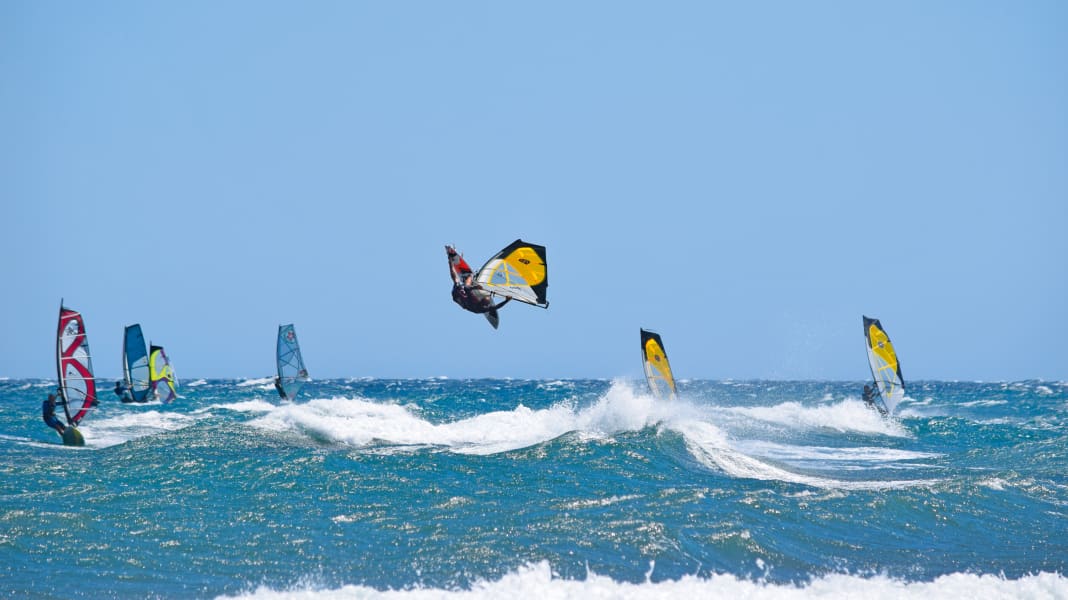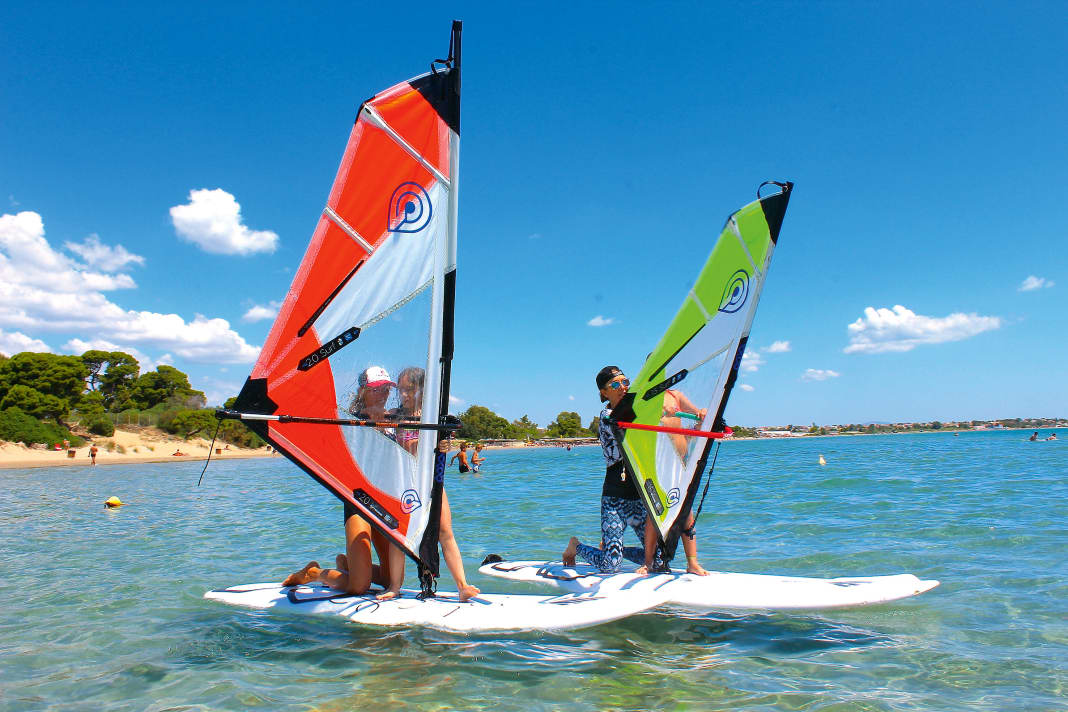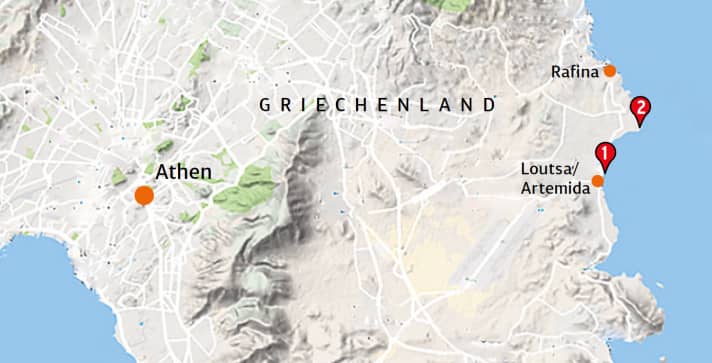
Travellers should not be slowed down. For many holidaymakers in Greece, the roaring hot and stuffy metropolis of Athens is worth a day trip at best, before they finally set off from the nearby port of Piraeus on their onward journey to the surfing strongholds of Naxos, Paros, Rhodes or Crete. Just get away!
Very few windsurfers know that there are a number of excellent spots just 50 kilometres east of the place where they are about to drive their camper onto a rickety Greek ferry. The place with the best overall package for many windsurfers and especially for families is the village of Loutsa, also known as Artemida. Here, the little ones splash around in the warm water on a sandy beach, tavernas, bars and accommodation are within walking distance and the water offers the full range from flat water to powerful surf waves. If the wind doesn't blow, the proximity to the cultural metropolis of Athens is suddenly a welcome change - the cultural programme and windsurfing culture are simply unbeatably close to each other here.






Perhaps the following spot guide will be a good incentive to end your next surf trip to Greece on the Greek mainland for a change. Sometimes you have to stop travellers.
"Where is the sky? I saw it in the middle of the sea!"
Odysseas Elytis, winner of the Nobel Prize for Literature
Windsurfing in Loutsa - general information
Journey: Loutsa is only around ten kilometres from Athens International Airport. Connections are possible from many Central European cities. As always, it is important to check the airlines' baggage conditions and to register surf baggage in advance. From the airport itself, the easiest ways to reach your accommodation in Loutsa are by taxi (approx. 15 minutes) or by bus (KTEL, approx. 3.50 euros). If you are travelling by camper van, it is best to book a ferry from Italy (e.g. Ancona, Venice, Trieste) to Patras, from where you can reach Loutsa in around three hours. Numerous ferry offers at:
- Blue Star: www.bluestarferries.gr/en
- Minoan: www.ferries.gr/minoan/deutsch
- Anek: www.ferries.gr/anek/deutsch
Wind, weather & neoprene recommendation: Loutsa is also supplied by the Meltemi summer wind. This is created by a heat low over the southern Aegean and the Turkish mainland, which draws in air from the north. The best wind season is therefore between May and October, but good Meltemi phases are also possible in spring and late autumn. Temperatures are then bearable, with the thermometer climbing to over 20 degrees on average in May and October, while in summer, blistering heat is often the order of the day - especially when there is no wind. In spring and autumn, a 4/3 neo is always sufficient, but in midsummer shorties or board shorts are the order of the day when the water is 25 degrees. The Meltemi usually blows from the north to north-east. If there is no summer wind, a moderate thermal often sets in in the afternoon with an average of 10-16 knots from the south-east - so you can almost always glide with large sails. Wind forecasts at www.windfinder.com/forecast/loutsa or www.poseidon.hcmr.gr
Living & Camping:If Loutsa also had a campsite in the immediate vicinity, it would probably be the perfect place. To make the 15-minute drive to the Kokkino Limanaki campsite ten kilometres to the north (http:// athenscampings.com ) - wild camping is prohibited in Greece and is only tolerated in the low season. In Loutsa/Artemida itself, you can choose between a variety of flats, hotels and B&Bs in different price categories.Local tip: Rafina Avra Hotel and the Aquis Mare Nostrum Hotel.
Surf stations: The Tony Frey Windsurf Club is located directly at the spot (http:// tonyfrey.gr ), at the southern end of the three-kilometre-long bay, just north of the small fishing port of Artemida. The surf school can be reached via the trendy Albatross Beach Club from the street or beach side. The German-Greek Tony and her team offer year-round surf lessons for beginners and advanced surfers at this VDWS school. If the conditions allow, you can also book private beginner courses here, with content such as jumping or wave riding. The latest equipment from Goya is available. It is also possible to store your own equipment, hire SUP boards or book surfing lessons when it is calm.
At the nearby wavespot Nissakia, Athens Watersports ( www.athenswatersports.gr ) and the Nissakia Surf Club (http:// nissakia.gr/en ) other stations - some of the rental equipment here is not up to date.
Surf shops: Replacements for broken material are available from Right Stuff ( www.rightstuff.gr ), Windsurfing at 100 ( www.windsurfingat100.gr ) and Wind Warrior ( www.facebook.com/windwarrior.gr ).
Alternative programme: Athens is a must! If you need to cool off, you can go SUPing, diving, water skiing and much more around Loutsa.
Downsides: The heat in midsummer when there is no wind, the crowds on windy weekends and many kiters at the wave spot Nissakia can spoil the fun.
The best spots

1) Loutsa
The lively village of Loutsa, also known as Artemida, is located just a few kilometres north-east of Athens airport and around 35 kilometres east of the centre of Athens. With its fine sand and safe shallow water, the three-kilometre-long bay is ideal for families and shallow water fans. As the wind is usually weaker in the morning and a small standing area stretches out almost 70 metres, up-and-comers also get their money's worth. There are no dangers such as shallows or currents lurking in the bay. Loutsa works in many wind directions, except for the offshore and rare westerly wind. Thermal south-easterly winds blow onshore, perfect is Meltemi from north to north-east, which blows sideshore from the left. Apart from a few chops, the water remains pleasantly smooth even in strong winds above force five - perfect for chasing your personal record with the slalom board or honing jibes or freestyle tricks in peace. The fact that kitesurfing is prohibited in the bay between May and October contributes significantly to relaxation.
2) Nissakia
Those who like real surf waves should head to the northern end of the bay, where the wave spot Nissakia is located. Strong meltemi whistles through a gulley between the inhabited headland and the offshore archipelago, creating surf between one and two metres high that breaks over a reef. With wind from the left, you can then spiral into the sky with sideonshore winds. But beware: Nissakia has large rocks under the water and a long reef adorned with sea urchins that once connected the offshore islands to the mainland. This wave spot is therefore more suitable for experienced surfers with their own equipment. Word of the good conditions in Nissakia has also spread to the kite scene, although they have to clear the spot from wind force 6 - even if not all kiters stick to this rule, there is still more space. In summer there is a bit of parking chaos here and there is no sandy beach, just a narrow, stony entrance. Those who like to have their peace and quiet while wave surfing can head to Rafina, seven kilometres to the north, on days with good meltemi. The wave is even higher here and breaks relatively harmlessly on sand when the wind blows diagonally onshore. The start is downwind of the harbour and the spot is equally suitable for jumping and riding.

